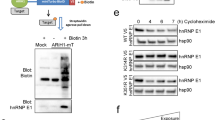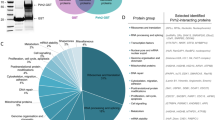Abstract
RING-finger proteins play crucial roles in ubiquitination events involved in diverse cellular processes including signal transduction, differentiation and apoptosis. Most of the RING-finger proteins have E3-ubiquitin ligase activity. RNF11 is a small RING-finger protein and harbors a RING-H2 domain and a PY motif that could facilitate protein:protein interaction(s) involved in oncogenesis. To isolate RNF11 protein partners and determine its role in normal and cancer cells, we performed yeast two-hybrid screening. Among 18 in-frame positive clones, three were found to be ZBRK1, Eps15 and AMSH (associated molecule with the SH3 domain of STAM). ZBRK1 is a KRAB domain containing Zinc-finger protein and is known to repress target gene transcription in a BRCA1-dependent manner. Eps15 is monoubiquitinated and is part of an essential complex involved in the endocytosis of plasma membrane receptors via the clathrin-mediated internalization pathway. Recent studies have shown that AMSH protein is involved in BMP/TGF-β signaling pathway by binding to Smad6 and Smad7. The association of RNF11 with these binding partners suggests that it would be involved in biological processes such as gene transcription, BMP/TGF-β signaling and ubiquitination-associated events. Previously, we have shown that RNF11 interacts with the HECT-type E3 ligases AIP4 and Smurf2. Here, we show that RNF11 binds to AMSH in mammalian cells and that this interaction is independent of the RNF11 RING-finger domain and the PY motif. Our results also demonstrate that AMSH is ubiquitinated by Smurf2 E3 ligase in the presence of RNF11 and that a consequent reduction in its steady-state level requires both RNF11 and Smurf2. RNF11 therefore recruits AMSH to Smurf2 for ubiquitination, leading to its degradation by the 26S proteasome. The potential functions of RNF11-mediated degradation of AMSH in breast cancer are discussed.
This is a preview of subscription content, access via your institution
Access options
Subscribe to this journal
Receive 50 print issues and online access
$259.00 per year
only $5.18 per issue
Buy this article
- Purchase on Springer Link
- Instant access to full article PDF
Prices may be subject to local taxes which are calculated during checkout







Similar content being viewed by others
References
Bache KG, Raiborg C, Mehlum A and Stenmark H . (2003). J. Biol. Chem., 278, 12513–12521.
Bean AJ, Davanger S, Chou MF, Gerhardt B, Tsujimoto S and Chang Y . (2000). J. Biol. Chem., 275, 15271–15278.
Bonni S, Wang HR, Causing CG, Kavsak P, Stroschein SL, Luo K and Wrana JL . (2001). Nat. Cell Biol., 3, 587–595.
Burger A, Li H, Zhang XK, Pienkowska M, Venanzoni M, Vournakis J, Papas T and Seth A . (1998). Oncogene, 16, 327–333.
Carbone R, Fre S, Iannolo G, Belleudi F, Mancini P, Pelicci PG, Torrisi MR and Di Fiore PP . (1997). Cancer Res., 57, 5498–5504.
Hayashi H, Abdollah S, Qiu Y, Cai J, Xu YY, Grinnell BW, Richardson MA, Topper JN, Gimbrone Jr MA, Wrana JL and Falb D . (1997). Cell, 89, 1165–1173.
Ishii N, Owada Y, Yamada M, Miura S, Murata K, Asao H, Kondo H and Sugamura K . (2001). Mol. Cell. Biol., 21, 8626–8637.
Itoh F, Asao H, Sugamura K, Heldin CH, ten Dijke P and Itoh S . (2001). EMBO J., 20, 4132–4142.
Kavsak P, Rasmussen RK, Causing CG, Bonni S, Zhu H, Thomsen GH and Wrana JL . (2000). Mol. Cell, 6, 1365–1375.
Kay BK, Williamson MP and Sudol M . (2000). FASEB J., 14, 231–241.
Kitching R, Gish G, Burger A, Landberg G and Seth A . (2003). Biochim. Biophys. Acta, submitted.
Nuber U and Scheffner M . (1999). J. Biol. Chem., 274, 7576–7582.
Rotin D, Staub O and Haguenauer-Tsapis R . (2000). J. Membr. Biol., 176, 1–17.
Salcini AE, Chen H, Iannolo G, De Camilli P and Di Fiore PP . (1999). Int. J. Biochem. Cell Biol., 31, 805–809.
Sorkina T, Bild A, Tebar F and Sorkin A . (1999). J. Cell Sci., 112 (Part 3), 317–327.
Subramaniam V, Li HX, Wong M, Kitching R, Attisano L, Wrana J, Zubovits J, Burger A and Seth A . (2003). Br. J Cancer, 89, 1538–1544.
Tanaka N, Kaneko K, Asao H, Kasai H, Endo Y, Fujita T, Takeshita T and Sugamura K . (1999). J. Biol. Chem., 274, 19129–19135.
Waterman H and Yarden Y . (2001). FEBS Lett., 490, 142–152.
Weissman AM . (2001). Nat. Rev. Mol. Cell. Biol., 2, 169–178.
Welcsh PL, Owens KN and King MC . (2000). Trends Genet., 16, 69–74.
Zhang Y, Chang C, Gehling DJ, Hemmati-Brivanlou A and Derynck R . (2001). Proc. Natl. Acad. Sci., USA, 98, 974–979.
Zheng L, Pan H, Li S, Flesken-Nikitin A, Chen PL, Boyer TG and Lee WH . (2000). Mol. Cell, 6, 757–768.
Zhu H, Kavsak P, Abdollah S, Wrana JL and Thomsen GH . (1999). Nature, 400, 687–693.
Acknowledgements
We thank Jeff Wrana and Liliana Attisano for helpful discussions and Richard for editorial assistance. This work was funded by grants from the Canadian Breast Cancer Research Alliance and Oncostasis, USA to A Seth.
Author information
Authors and Affiliations
Corresponding author
Rights and permissions
About this article
Cite this article
Li, H., Seth, A. An RNF11: Smurf2 complex mediates ubiquitination of the AMSH protein. Oncogene 23, 1801–1808 (2004). https://doi.org/10.1038/sj.onc.1207319
Received:
Revised:
Accepted:
Published:
Issue Date:
DOI: https://doi.org/10.1038/sj.onc.1207319
Keywords
This article is cited by
-
Smurf2 inhibition enhances chemotherapy and radiation sensitivity in non-small-cell lung cancer
Scientific Reports (2022)
-
Downregulation of Smurf2 ubiquitin ligase in pancreatic cancer cells reversed TGF-β-induced tumor formation
Tumor Biology (2016)
-
RNF11 is a GGA protein cargo and acts as a molecular adaptor for GGA3 ubiquitination mediated by Itch
Oncogene (2015)
-
SARA and RNF11 interact with each other and ESCRT-0 core proteins and regulate degradative EGFR trafficking
Oncogene (2013)
-
Neuronal RING finger protein 11 (RNF11) regulates canonical NF-κB signaling
Journal of Neuroinflammation (2012)



